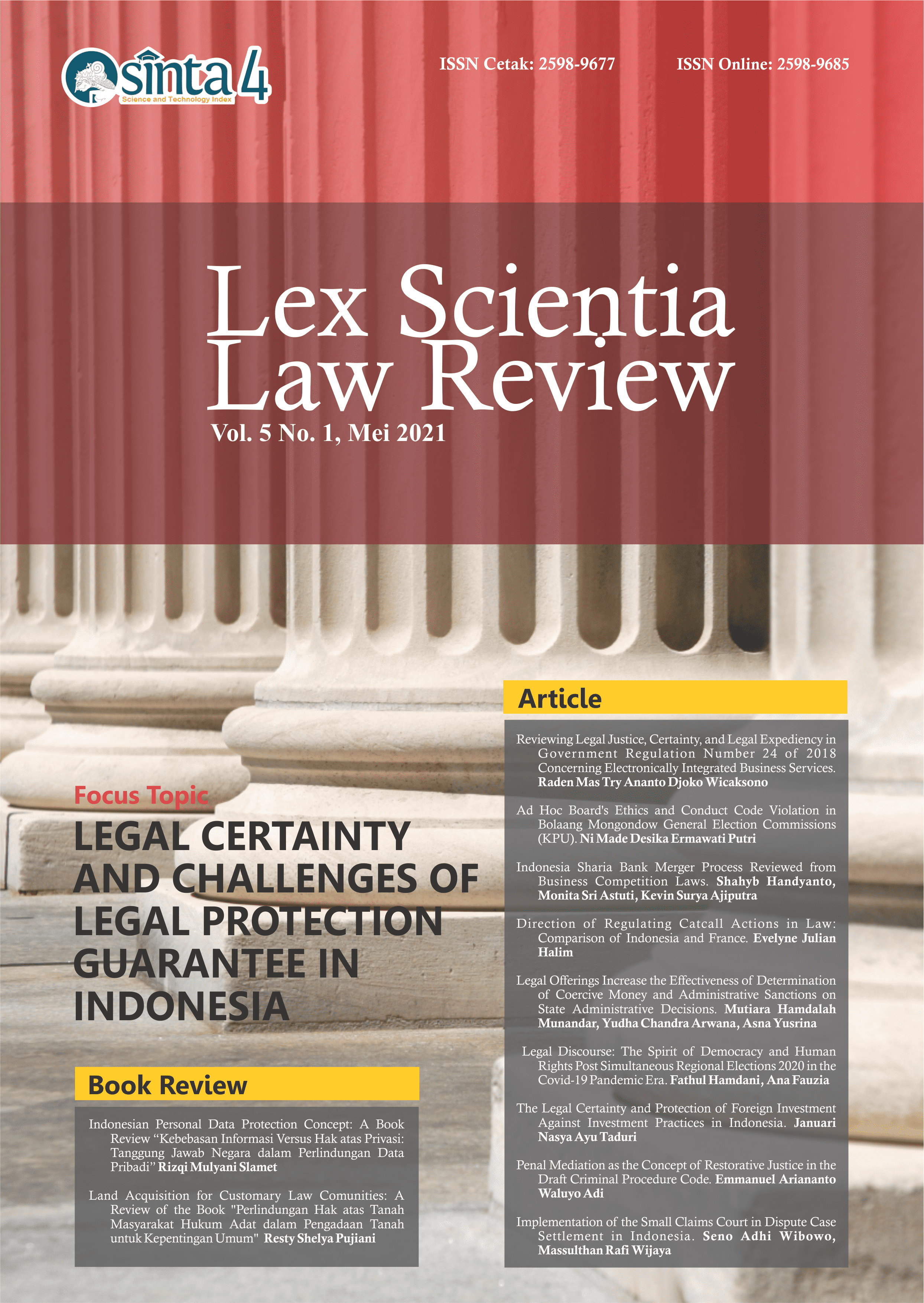Direction of Regulating Catcall Actions in Law: Comparison of Indonesia and France Law
Main Article Content
Abstract
Various forms of harassment in the world are increasing, including in Indonesia. Women and children are the most frequent victims of sexual harassment, but it does not rule out that men can become victims. Catcalling is an act that has sexual implications for the victim with teasing, whistling, screaming, comments, and even eye contact on the street or in public places. Sexual harassment negatively impacts victims such as shame, offense, humiliation, anger, loss of self-esteem, loss of chastity, depression, etc. Writing this scientific article aims to provide reference material for lawmakers regarding the ideal regulation of street harassment, especially catcalling. Then, give the readers an understanding of catcalling and the urgency of its rule in Indonesian legislation. The research method used in this scientific article is a normative juridical method with data collection techniques using literature study by examining secondary data, namely statutory regulations, other legal documents, research results, assessment results, and other references. This study uses a statute approach, conceptual approach, and comparative approach. This verbal sexual harassment has been taken seriously in several countries, one of which is France. In France, this anti-catcalling Law is known as Loi Schiappa. Loi Schiappa gave direct fines to the perpetrators of catcalling. In Indonesia, there is no regulation regarding catcalling, resulting in a legal vacuum. Indonesia can follow the model of the French Catcalling arrangement, which uses direct fines on the spot. So that provides legal certainty as well as protects the human rights of victims of catcalling.
Article Details
All writings published in this journal are personal views of the authors and do not represent the view of this journal and the author's affiliated institutions. Authors retain the copyrights under this license, see our copyrights notice.
References
Brox Sáenz de la Calzada, A. (2019). Acoso sexista callejero: Qué respuesta puede ofrecer el Derecho penal? (Sexist Street Harassment: What Kind of Answer Can the Penal Law Provide?), Oñati Socio-Legal Series (online), 9(6), 983–1000. https://doi.org/10.35295/osls.iisl/00000000-0000-1080.
Brundsdon, D. (2018). Legal Solutions to Street Sexual Harassment in the #MeToo Era, Atlantis, 39(2), 40–56. https://doi.org/10.7202/1064071ar.
Chazawi, A. (2005). Tindak Pidana Mengenai Kesopanan. Jakarta: Rajagrafindo.
Criminal Code.
Dewan Perwakilan Rakyat. (2017). Naskah Akademik Rancangan Undang-Undang tentang Penghapusan Kekerasan Seksual, accessed from https://www.dpr.go.id/dokakd/dokumen/RJ1-20170307-091105-5895.pdf.
Dewi, I. A. A. (2019). Catcalling: Candaan, Pujian atau Pelecehan Seksual, Acta Comitas Jurnal Hukum Kenotariatan, 4(2), 198-212. https://doi.org/10.24843/AC.2019.v04.i02.p04.
Efendi, J., Ibrahim, J. (2018). Metode Penelitian Hukum: Normatif dan Empiris. Depok: Prenadamedia Group.
Fakih. (1996). Analisis Gender dan Transformasi Sosial. Yogyakarta: Pustaka Belajar.
Fileborn, B. (2016). Justice 2.0: Street Harassment Victims' Use Of Social Media And Online Activism As Sites Of Informal Justice, British Journal Of Criminology, 57(6), 1482-1501. https://doi.org/10.1093/bjc/azw093.
Fileborn, B., Gray, F.V. (2017). I Want to be Able to Walk the Street Without Fear: Transforming Justice for Street Harassment, Feminist Legal Studies, 25(2), 203–227. https://doi.org/10.1007/S10691-017-93503-3.
Fillion, S. (Januarr, 2021). "2 Years Later, What We Can Learn From France's Anti-Catcalling Law", Forbes, January 26, 2021, accessed from https://www.forbes.com/sites/stephaniefillion/2021/01/26/2-years-later-what-we-can-learn-from-frances-anti-catcalling-law/?sh=208cdae375dc.
Hébert, L. C. (2019). Dignity and Discrimination in Sexual Harassment Law: A French Case Study, Washington and Lee Journal of Civil Rights and Social Justice ,25(1), 1-38.
Karsoma, A. (2020). Perlindungan Hukum Hak Paten Aphankam. Bandung: PT Penerbit.
Kartika, Y., Najemi, A. (2020). Kebijakan Hukum Perbuatan Pelecehan Seksual (Catcalling) dalam Perspektif Hukum Pidana, Pampas: Journal of Criminal, 1(2). https://doi.org/10.2139/ssrn.3239557.
Lamintang, P. A. F. (1989). Hukum Penitensier indonesia. Bandung: CV Armico.
O' Leary, C. (2016). Catcalling As a "Double Edged Sword": Midwestern Women, Their Experiences, and The Implications of Men's Catcalling Behaviors, Theses and dissertation, Illinois State University. https://ir.library.illinoisstate.edu/cgi/viewcontent.cgi?article=1534&context=etd.
Putri, L. J., Suardita, I. K. (2019). Tinjauan Yuridis Terhadap Perbuatan Catcalling (Pelecehan Verbal) Di Indonesia. Kertha Wicara, 8(2), 1–15. https://ojs.unud.ac.id/index.php/kerthawicara/article/view/47598.
Republic of Indonesia. (2002). 1945 Constitution of Republic of Indonesia.
Republic of Indonesia. (2008). Law Number 44 of 2008 concerning Pornography. State Gazette Number 181 of 2008, Supplement to the State Gazette Number 4928. Available online on https://www.hukumonline.com/pusatdata/detail/28607/undangundang-nomor-44-tahun-2008#.
Rizky, P. A. (March, 2018). “Catcalling dan Mimpi Buruk Perempuan di Jalan”, alinea.id, March 18, 2018, accessed from https://www.alinea.id/gaya-hidup/catcalling-dan-mimpi-buruk-perempuan-di-jalan-b1UvT9I8.
Saraswasti, P. W. (November, 2015). “Catcalling: Pelecehan Terhadap Perempuan”, Putri Widi Saraswati, November 29, 2015, accessed from https://putriwidisaraswati.wordpress.com/2015/11/29/catcalling-pelecehan-terhadap-perempuan/.
Simbolon, D. F. (2018). Minimnya Pendidikan Reproduksi Dini Menjadi Faktor Penyebab Terjadinya Pelecehan Seksual Antar Anak, Soumatera Law Review, 1(1), 43–46. https://media.neliti.com/media/publications/284753-kurangnya-pendidikan-reproduksi-dini-men-37b7f836.pdf.
Soekanto, S. (2004). Faktor-Faktor Yang Mempengaruhi Penegakan Hukum, Cetakan Kelima. Jakarta: Raja Grafindo Persada.
Tauratiya. (2020). Perbuatan Catcalling dalam Perspektif Hukum Positif. Ekspose: Jurnal Penelitian Hukum dan Pendidikan ,19(1), 1019–1025. https://doi.org/10.30863/ekspose.v1i1.690.
The IWI: International Women's Initiative. (April, 2020). "Street Harassment: The Inadequacy of European Laws", The IWI: International Women's Iniative, April 9, 2020, accessed from https://www.theiwi.org/gpr-reports/belgium-france-portugal-catcalling-law.
Tschapka, L. (2018). A Threat to Free Speech? Overcoming the Dilemma. UBT International Conference, 385. https://knowledgecenter.ubt-uni.net/cgi/viewcontent.cgi?article=2007&context=conference.
Wilkes, E. (February, 2021). "The Dangerous Impact of Catcalling on Women", The boar, February 11, 2021, accessed from https://theboar.org/2021/02/catcalling-experiences/.
